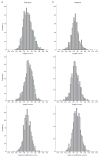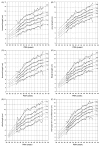An anthropometric survey of US pre-term and full-term neonates
- PMID: 29037091
- PMCID: PMC5794488
- DOI: 10.1080/03014460.2017.1392603
An anthropometric survey of US pre-term and full-term neonates
Abstract
Background: Anthropometric data prove valuable for screening and monitoring various medical conditions. In young infants, however, only weight, length and head circumference are represented in publicly accessible databases.
Aim: To characterise length and circumferential measures in pre-term and full-term infants up to 90 days post-natal.
Subjects and methods: In eight US medical centres, trained raters recorded humeral, ulnar, femoral, tibial and fibular lengths along with mid-upper arm, mid-thigh, chest, abdominal and neck circumference. Data were pooled by post-menstrual age into 1-week intervals and population curves created using the lambda, mu and sigma (LMS) method. Goodness-of-fit was assessed by examining de-trended quantile-quantile plots, Q statistics and fitted centiles overlaid on empirical centiles.
Results: In total, 2097 infants were enrolled in this study with a mean ± SD gestational age and post-natal age of 37.1 ± 3.3 weeks and 27.3 ± 25.3 days, respectively. A re-scale option was used to describe all curves. The resultant models reliably characterised anthropometric measures from 33-52 weeks PMA, with less certainty at the extremes (27-55 weeks).
Conclusion: The population curves generated under this investigation expand existing reference data on a comprehensive set of anthropometric traits in infants through the first 90 days post-natal.
Keywords: Extra-uterine growth; anthropometry; circumference; growth reference; infants; limb length.
Conflict of interest statement
No potential conflict of interest was reported by the authors.
Figures



Similar articles
-
Gestational age-specific centile charts for anthropometry at birth for South Indian infants.Indian Pediatr. 2012 Mar;49(3):199-202. doi: 10.1007/s13312-012-0060-2. Epub 2011 Aug 15. Indian Pediatr. 2012. PMID: 21992862
-
Revised birth centiles for weight, length and head circumference in the UK-WHO growth charts.Ann Hum Biol. 2011 Jan;38(1):7-11. doi: 10.3109/03014460.2011.544139. Ann Hum Biol. 2011. PMID: 21175302
-
International standards for newborn weight, length, and head circumference by gestational age and sex: the Newborn Cross-Sectional Study of the INTERGROWTH-21st Project.Lancet. 2014 Sep 6;384(9946):857-68. doi: 10.1016/S0140-6736(14)60932-6. Lancet. 2014. PMID: 25209487
-
A systematic review and meta-analysis to revise the Fenton growth chart for preterm infants.BMC Pediatr. 2013 Apr 20;13:59. doi: 10.1186/1471-2431-13-59. BMC Pediatr. 2013. PMID: 23601190 Free PMC article. Review.
-
Short versus long feeding interval for bolus feedings in very preterm infants.Cochrane Database Syst Rev. 2021 Aug 19;8(8):CD012322. doi: 10.1002/14651858.CD012322.pub2. Cochrane Database Syst Rev. 2021. PMID: 34415568 Free PMC article. Review.
Cited by
-
Validation and human factor analysis study of an infant weight estimation device.BMC Pediatr. 2020 Jan 22;20(1):30. doi: 10.1186/s12887-020-1933-5. BMC Pediatr. 2020. PMID: 31969129 Free PMC article.
-
Reference Values for Abdominal Circumference in Premature Infants.Front Pediatr. 2020 Feb 13;8:37. doi: 10.3389/fped.2020.00037. eCollection 2020. Front Pediatr. 2020. PMID: 32117842 Free PMC article.
-
Optimizing individual nutrition in preterm very low birth weight infants: double-blinded randomized controlled trial.J Perinatol. 2020 Apr;40(4):655-665. doi: 10.1038/s41372-020-0609-1. Epub 2020 Feb 18. J Perinatol. 2020. PMID: 32071367 Clinical Trial.
-
A Weight Estimation Strategy for Preterm and Full-Term Infants.Glob Pediatr Health. 2017 Dec 21;4:2333794X17748775. doi: 10.1177/2333794X17748775. eCollection 2017. Glob Pediatr Health. 2017. PMID: 29308426 Free PMC article.
References
-
- Anton SC, Snodgrass JJ Bones and Behavior Working Group. Integrative measurement protocol for morphological and behavioral research in human and non-human primates. 2009 Available online at: http://www.bonesandbehavior.org/protocol.pdf.
-
- Arisoy AE, Sarman G. Chest and mid-arm circumferences: identification of low birth weight newborns in Turkey. J Trop Pediatr. 1995;41:34–37. - PubMed
-
- Bhatia J. Growth curves: how to best measure growth of the pre-term infant. J Pediatr. 2013;162:S2–S6. - PubMed
Publication types
MeSH terms
Grants and funding
LinkOut - more resources
Full Text Sources
Other Literature Sources
Research Materials
